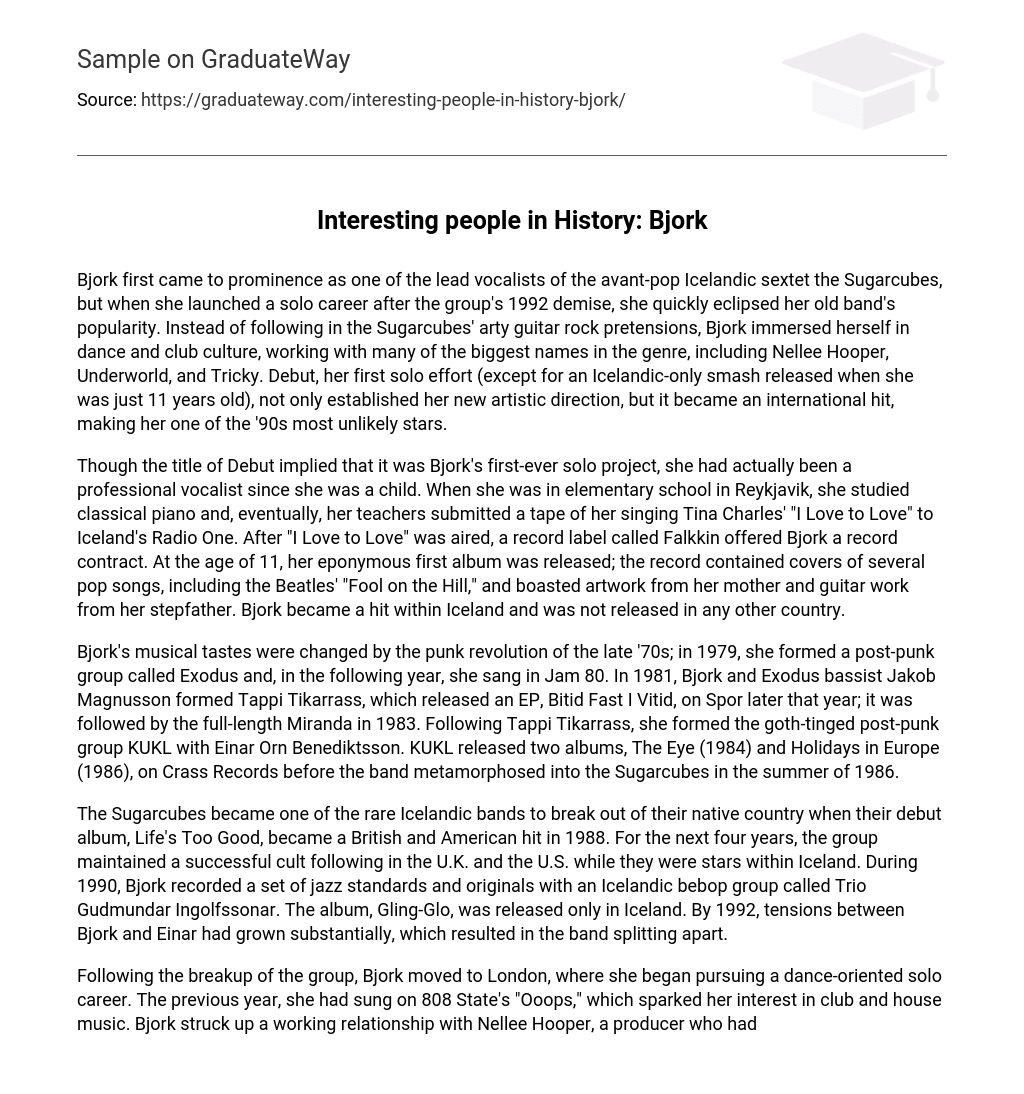Bjork originally gained fame as a lead vocalist in the acclaimed Icelandic group, the Sugarcubes. However, after the band disbanded in 1992, she embarked on a solo career that quickly overshadowed her former band’s success. In contrast to the Sugarcubes’ artistic guitar rock style, Bjork immersed herself in the world of dance and club culture. Collaborating with notable figures such as Nellee Hooper, Underworld, and Tricky, she ventured into this genre. Her debut album, named Debut, not only marked her artistic shift but also achieved worldwide popularity, making her an unexpected star of the 1990s.
Although Debut was titled as Bjork’s first-ever solo project, she had been a professional vocalist since her childhood. During her time at elementary school in Reykjavik, she took classical piano lessons and eventually her teachers submitted a tape of her singing Tina Charles’ “I Love to Love” to Iceland’s Radio One. Falkkin, a record label, offered Bjork a record deal after the song was aired. At the young age of 11, she released her self-titled debut album which included covers of various pop songs such as the Beatles’ “Fool on the Hill.” The album featured artwork by her mother and guitar work by her stepfather. Although it gained popularity in Iceland, Bjork’s debut album was not released in any other country.
Bjork’s music taste was influenced by the punk revolution in the late 1970s. In 1979, she formed a post-punk band called Exodus and, in the next year, she performed in Jam 80. In 1981, Bjork and Jakob Magnusson, the bassist of Exodus, teamed up to create Tappi Tikarrass. This group released a EP called “Bitid Fast I Vitid” on Spor later that year and then a full-length album named “Miranda” in 1983. Following Tappi Tikarrass, Bjork collaborated with Einar Orn Benediktsson to form KUKL, a goth-tinged post-punk band. KUKL released two albums, “The Eye” (1984) and “Holidays in Europe” (1986), on Crass Records before transforming into the Sugarcubes in the summer of 1986.
The Sugarcubes achieved international success with their debut album, Life’s Too Good, in 1988. This made them one of the few Icelandic bands to break out of their home country. While they were popular stars in Iceland, the group also developed a devoted following in the UK and the US for the next four years. In 1990, Bjork collaborated with the Icelandic bebop group Trio Gudmundar Ingolfssonar to record a mix of jazz standards and original songs. Their album, Gling-Glo, was exclusively released in Iceland. However, by 1992, tensions between Bjork and Einar had escalated significantly, leading to the band’s ultimate breakup.
After the group disbanded, Bjork relocated to London where she embarked on a solo career focused on dance music. Prior to this, she had featured as a vocalist on 808 State’s track “Ooops,” which ignited her fascination with club and house music. Bjork established a professional alliance with Nellee Hooper, a producer who had previously worked with Soul II Soul and Massive Attack. Their collaboration produced their first achievement, “Human Behaviour,” which came out in June 1993. The song climbed the charts in the UK, landing in the Top 40 and paving the way for Bjork’s unexpected debut album success with Debut, which debuted at an impressive third position. In 1993, Bjork also had several hit singles in the UK such as “Venus as a Boy,” “Big Time Sensuality,” and “Play Dead,” a non-album track she created in collaboration with David Arnold for the movie Young Americans. These tracks were well-received on modern rock radio stations in the US and UK, and critics showered her with praise in both countries. At the close of the year, Debut was honored as NME magazine’s album of the year, and Bjork herself received accolades at the BRIT Awards for International Female Solo Artist and Newcomer. Debut attained gold certification in the US and platinum status in the UK.
In 1994, Bjork collaborated with various artists for her second album. These artists included Nellee Hooper, Tricky, Graham Massey from 808 State, and Howie B from Mo’ Wax Records. She also released a remix EP and co-wrote the title track for Madonna’s Bedtime Stories. Additionally, she performed on MTV Unplugged.
In spring of 1995, Bjork released “Army of Me,” which was the first single from her upcoming album. The song achieved success in both the UK and as an alternative rock hit in the US. Her second album, titled Post, received positive reviews upon its release in June 1995. It reached number two in the UK and number 32 in the US. Post earned her a gold certification in the US and her second BRIT Award for Best International Female Artist.
Post featured successful British singles such as “Isobel,” “It’s Oh So Quiet,” and “Hyperballad.” However, it did not gain much traction on American radio or MTV.
In late 1996, Bjork released Telegram in the UK. This album consisted of radical remixes of all the songs from Post. It was later released in America in January 1997.
Later that same year, Bjork released Homogenic which became her most experimental studio effort to date. This album led to numerous remix releases over the following years.
In the spring of 2000, Bjork won Best Actress at Cannes Film Festival for her role in Lars von Trier’s Palme d’Or-winning film Dancer in the Dark.Her collaboration with Mark Bell on Homogenic led to the release of Selmasongs, the film’s score released in autumn 2000 concurrent with its U.S. release. A year later, Bjork followed up with her album Vespertine. In late 2002, she released a collection of her greatest hits and the Family Tree box set. After performing at several shows in 2003, she prepared for an eventful 2004 that included the release of Medulla, an album solely comprised of vocals and vocal samples. At the 2004 Summer Olympics in Athens, Greece, she performed one of its songs called “Oceania.”





